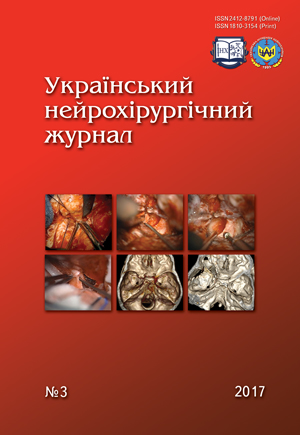The content of middle-weight molecules in the peripheral blood of patients with brain tumors of different histostructure
DOI:
https://doi.org/10.25305/unj.112092Keywords:
brain tumors, middle-weight moleculesAbstract
Background. In tumor processes in the body the local inflammatory reactions occur, antitumor immunity is impaired and various low-molecular factors level increases in peripheral blood, particular middle-weight molecules (MWM).The content and nature of these substances depends on the characteristics of pathological processes in the body.
Aim was to determine the blood MWM level in patients with brain tumors.
Materials and methods. The study included 39 blood samples of patients with brain tumors and 11 blood samples of healthy people. MWM level was determined by NI Gabrielyan method with spectrophotometric determination at a wave length of 254 and 280 nm. The results were processed using statistical methods.
Results. The patients with brain tumors were found to have increased MWM level in peripheral blood compared to healthy individuals, especially when set at 254 nm. MWM level depended on tumors histostructure with slightly higher concentration in glial tumors and pituitary adenomas compared to meningioma and metastases.
Conclusion. MWM level in the blood of patients with brain tumors depends on tumor nature and may serve as an indicator of inflammatory and metabolic processes in the body in the combined modality treatment of brain tumors.
References
1. Karyakina EV, Belova S.V. Molekuly sredney massy kak integral’nyy pokazatel’ metabolicheskikh narusheniy (obzor literatury). Klinicheskaya laboratornaya diagnostika. 2004;(4):3-10. Russian.
2. Gromashevskaya LL. «Srednie molekuly» kak odin iz pokazateley «metabolicheskoy intoksikatsii» v organizme. Laboratornaya diagnostika. 1997;(1):11-16. Russian.
3. Gabrielyan NI, Dmitriev AI, Kulakov GP, Melikyan AM, Shcherbaneva OI. Diagnosticheskaya tsennost’ opredeleniya «srednikh molekul» v plazme krovi pri nefrologicheskikh zabolevaniyakh. Klinicheskaya meditsina. 1981;(10):38-42. Russian.
4. Kishkun AA, Kudinova AS, Ofitova AD, Mishurina RB. Znachenie «srednikh molekul» v otsenke urovnya endogennoy intoksikatsii. Voenno-meditsinskiy zhurnal. 1990;(2):41-44. Russian.
5. Gabrielyan NI, Levitskiy ER, Dmitriev AA. Skriningovyy metod opredeleniya srednikh molekul v biologicheskikh zhidkostyakh: Metodicheskie rekomendatsii. Moscow; 1985. 23 р. Russian.
6. Nemchenko NS, Belozerova LA,EryukhinIA, Shanin VYu, Chernyakov GM. Rol’ srednemolekulyarnykh peptidov v patogeneze travmaticheskoy bolezni. Vestnik khirurgii imeni II Grekova. 1994;7(12):65-69. Russian.
7. Val’dman BM, Volchegorskiy IA, Puzhevskiy AS, Yarovinskii BG, Livshits RI. Srednemolekulyarnye peptidy krovi kak endogennye regulyatory perekisnogo okisleniya lipidov v norme i termicheskikh ozhogakh. Voprosy meditsinskoy khimii. 1991;37(1):23-26. Russian.
8. Metal’nykova AN, Hromashevs’ka LL, Markov IS, Antonyak KR, Myronova NI, Yanushevs’ka RI. Efektyvnist’ enterosorbtsiynoyi terapiyi u likuvanni khvorykh na SNID i VIL-nosiyiv. Abstracts of the Conference «HIV / AIDS Problems»; 26 January 1995;Kiev,Ukraine.Kiev; 1995. P. 119-120. Ukrainian.
9. Gavrilov VB, Bidula MM, Furmanchuk DA, Konev SV, Aleynikova OV. Otsenka intoksikatsii organizma po narusheniyu balansa mezhdu nakopleniem i svyazyvaniem toksinov v plazme krovi. Klinicheskaya laboratornaya diagnostika. 1999;(2):13-15. Russian.
10. Nikolaychik VV. Molekulyarnye mekhanizmy razvitiya endogennoy intoksikatsii i sovershenstvovanie putey detoksikatsii [dissertation].Minsk(Belarus): Minsk Medical Institute. 1984. Russian.
11. Nikolaychik VV, Moin VM, Kirkovskiy VV, Mazur LI, Lobacheva GA, Bychko GN, Baratashvili GG. Sposob opredeleniya «srednikh molekul». Laboratornoe delo. 1991;(10):13-18. Russian.
12. Galaktionov SG, Nikolaichik VV, Tseitin VM, Mikhneva LM. “Middle molecules” Endotoxins of peptide nature. Pharmaceutical Chemistry Journal. Springer Nature; 1983 Nov;17(11):759–65. [CrossRef]
13. Xu X, Liu X, Ling Q, Wei Q, Liu Z, Xu X, Zhou L, Zhang M, Wu J, Huang J, Sheng J, Zheng S, Li L. Artificial liver support system combined with liver transplantation in the treatment of patients with acute-on-chronic liver failure. PLoS One. 2013;8(3):e58738. [CrossRef] [PubMed] [PubMed Central]
14. Xu Q, Schett G, Perschinka H, Mayr M, Egger G, Oberhollenzer F, Willeit J, Kiechl S, Wick G. Serum soluble heat shock protein 60 is elevated in subjects with atherosclerosis in a general population. Circulation. 2000 Jul 4;102(1):14-20. [CrossRef] [PubMed]
15. Rutkowski P, Słominska EM, Szołkiewicz M, Aleksandrowicz E, Smolenski RT, Wołyniec W, Renke M, Wisterowicz K, Swierczynski J, Rutkowski B. Relationship between uremic toxins and oxidative stress in patients with chronic renal failure. Scand J Urol Nephrol. 2007;41(3):243-8. [CrossRef] [PubMed]
16. Ayada K, Yokota K, Kobayashi K, Shoenfeld Y, Matsuura E, Oguma K. Chronic infections and atherosclerosis. Clin Rev Allergy Immunol. 2009 Aug;37(1):44-8. [CrossRef] [PubMed]
Downloads
Published
How to Cite
Issue
Section
License
Copyright (c) 2017 Nikolai I. Lisyanyi, Ludmila N. Belskaya, Diana N. Stanetskaya, Antonina I. Potapova

This work is licensed under a Creative Commons Attribution 4.0 International License.
Ukrainian Neurosurgical Journal abides by the CREATIVE COMMONS copyright rights and permissions for open access journals.
Authors, who are published in this Journal, agree to the following conditions:
1. The authors reserve the right to authorship of the work and pass the first publication right of this work to the Journal under the terms of Creative Commons Attribution License, which allows others to freely distribute the published research with the obligatory reference to the authors of the original work and the first publication of the work in this Journal.
2. The authors have the right to conclude separate supplement agreements that relate to non-exclusive work distribution in the form of which it has been published by the Journal (for example, to upload the work to the online storage of the Journal or publish it as part of a monograph), provided that the reference to the first publication of the work in this Journal is included.









